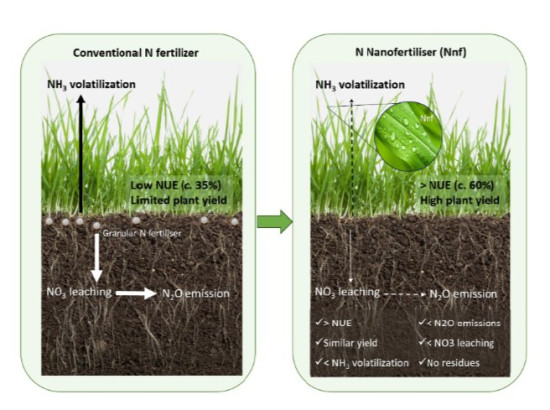What is nanotechnology?
Nanotechnology is the science of manipulating matter at an incredibly small scale—at the level of nanometres (billionths of a metre). At this scale, materials behave differently than they do in their normal, everyday form. It is an interdisciplinary field that blends physics, chemistry, biology, and engineering to create innovative solutions at the molecular level. In pastoral agriculture, nanotechnology has the potential to improve productivity, enhance animal health, and support environmental sustainability.
Does AgResearch use nanotechnology?
Yes. AgResearch is leading a research project called Foliar Nitrogen Nanofertilizers. The programme aims to reduce the environmental impact of dairy grazing systems by developing a more efficient method of delivering nitrogen to plants. Instead of traditional granular fertilisers, which are widely used by New Zealand farmers, the research is focused on creating a liquid alternative that can be sprayed directly to the leaves of grasses and plants. This approach is expected to be significantly more efficient and environmentally friendly.
Who is leading the project?
Dr Marta Alfaro is the Principal Investigator and Programme Lead. Originally from Chile, Marta is a nanotechnology expert with over two decades of experience researching soil processes and nitrogen use in pastoral agriculture. Her team combines expertise in nanotechnology, engineering, environmental science, and agronomy to assess the effectiveness and impact of this research.

What problem are you trying to solve?
Most nutrient losses from fertilisers occur through soil processes, leading to inefficiencies and environmental harm. Our approach seeks to bypass the soil by delivering nitrogen directly to plants via nanoparticles. This allows for more efficient nutrient uptake while reducing nitrogen losses to the environment. Essentially, we are adapting a new technology to solve an old problem.

Who are you working with?
We are collaborating with the International Iberian Nanotechnology Laboratory (INL) in Portugal . INL is a leading research institute dedicated exclusively to nanotechnology, with expertise in medicine, food processing, and nutrient delivery. Their knowledge of nanomaterials, bonding mechanisms, and controlled-release systems is highly relevant to our agricultural research.
What do you hope to deliver for farmers?
Our research is built on two key pillars:
- Using natural carriers – We are exploring materials that already exist in nature to ensure no additional residues enter the food chain or New Zealand’s agricultural systems.
- Sustainable nitrogen use – We have tested various organic nitrogen sources . Through careful selection, we have narrowed our focus to three promising nitrogen sources.
Our goal is to develop a prototype molecule that can be used as a fertiliser. We are now refining this prototype to ensure it delivers optimal benefits for farmers.
Where is the research taking place, and who are the stakeholders?
The research is being conducted at AgResearch’s Ruakura and Lincoln research centres. Our team includes principal and senior scientists, research assistants, and external collaborators.
A key aspect of this programme is our liaison group, which provides input from industry and regulatory perspectives. This group includes:
- The Fertiliser Association of New Zealand, ensuring a neutral and representative industry perspective
- The Waikato Regional Council, offering regulatory and environmental advice
By involving these stakeholders, we aim to develop a practical, scalable solution that meets both industry needs and environmental standards.
What stage is the research at?
We are currently developing and refining the prototype. Testing is being conducted in controlled environments, starting with:
- Laboratory trials to evaluate the chemical and physical properties of the fertiliser
- Glasshouse trials to assess its effects on plant growth, yield, and environmental impact
These trials will help determine whether the prototype can improve pasture and crop quality while reducing nitrogen losses through leaching, ammonia volatilisation, and nitrous oxide emissions.
Where do you expect to be in five years?
In five years, we aim to have at least one prototype that has been successfully tested and demonstrated to provide economic and environmental benefits to New Zealand agriculture.
By this stage, we will transition from small-scale controlled testing to paddock and field trials in collaboration with farmers and relevant industry.
What about commercialisation?
In ten years, we expect to have a commercially available product—or multiple products—on the market for New Zealand farmers. To achieve this, we will:
- Identify commercial partners
- Scale up production
- Navigate the regulatory approvals required for widespread use
Why hasn’t this been done before?
Historically, nitrogen fertiliser use in New Zealand has been dominated by granular forms, with about 70% applied in dairy systems. Over the last decade, intensification of dairy farming—particularly in regions like Canterbury and Waikato—has led to high nitrogen application rates and increased environmental concerns.
The focus in the past was on increasing production, but today, there is a greater awareness of sustainability. Our research aligns with this shift by developing more efficient and environmentally responsible fertilisation methods.
Why are you pursuing this research?
As scientists, we seek to understand agricultural challenges, but we also recognise that farmers need practical solutions. This project is driven by a commitment to:
- Providing innovative, science-based solutions to nitrogen efficiency problems
- Applying circular economy principles by repurposing agricultural and food waste into high-value fertilisers
By integrating cutting-edge nanotechnology with sustainable agricultural practices, we hope to create solutions that are both scientifically advanced and farmer-friendly.
Who are the key partners?
The core research team includes AgResearch and Lincoln University. INL (Portugal) is our primary international partner.
Additionally, our liaison group provides independent feedback, ensuring that the technology remains accessible to the broader agricultural industry . This approach maximises market potential and industry adoption.